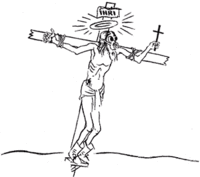George Grosz
Date: 1893-1959
Region: Europe, North America
Subject: Political/Economic/Social Opinion, Explicit Sexuality, Blasphemy
Medium: Mixed Media
Artist: George Grosz
Confronting Bodies: Weimar Republic, Nazis, Public Affairs Luncheon Club of Dallas, Los Angeles police, Italian authorities, United States customs
Dates of Action: 1920, 1923, 1928, 1932, 1937, 1955, 1962, 1969, 1970,
Location: Germany, United States, Italy
Description of Artwork: George Grosz's caricatures mocked the military, the business establishment, the clergy, and the politicians. His works were intended as an attack on German bourgeois culture. His caricatures are disarmingly blunt, often crude. Grosz used collage to distort and dismember. Grosz also had an obsession with the erotic and the sexual diversions of the bourgeois.
The Incident: At the First International Dada Fair, in Berlin, in the summer of 1920, Grosz got himself into trouble with the censors for the first time with some provocative anti-establishment pranks. The defense minister, Otto Gessler, brought charges against the caricaturist for insulting the honor and dignity of the armed forces in his drawing Off Duty, which portrays a soldier leaning idly against a tree looking at a mutilated corpse half-immersed in water.
In 1923 all copies of his erotic portfolio Ecce Homo were seized and Grosz and his publisher were ordered to stand trial.
In 1928 Grosz was asked by a well-known theater director to design the set for his play The Good Soldier Svejk. The anti-pacifist and anti-clerical drawings and designs were then published in the portfolio Background. The church took offense and brought charges of blasphemy in three of the drawings, one of which, entitled Shut Up and Soldier On, depicts Christ on a cross wearing a gas mask and army boots.
In 1932 Grosz left for exile in the United States and was named by the Nazis "Cultural Bolshevik Number 1", deprived of his citizenship, and many of his works burned.
In 1937, many of Grosz's works were pulled from German museums for their content and some were preserved as part of the 1937 Exhibit of Degenerate Art (Entartete Kunst) in Munich.
Even while in the United States, Grosz still faced censorship. In 1955 the Public Affairs Luncheon Club of Dallas, TX tried to have the work of Grosz and other communist artists removed from the Dallas Museum.
In 1962 the director of a gallery in Rome was fined and imprisoned for publishing a catalog which contained a number of Grosz's more erotic works.
In 1969 some of Grosz's works were seized by police from a gallery in Los Angeles and again by customs in 1970. In both cases charges were brought against the gallery organizers, but nothing every came of them.
Results of Incident: For the incident at the First International Dada Fair Grosz was fined 300 marks.
After the trial in 1923 Grosz and his publisher were each fined 6,000 marks and his offensive plates and drawings were ordered destroyed.
In 1928 Berlin court again fined Grosz and his publisher 6,000 marks and ordered the plates destroyed. Grosz and his friend appealed and, in one of the most enlightened court decisions of the 1920s, were acquitted before a Berlin state supreme court. The Reich Supreme Court ordered a retrial, but the judge held fast and again acquitted Grosz. The Reich Supreme Court again appealed and this time the judge gave in a little bit and banned Shut Up and Soldier On from the portfolio.
In Rome, all copies of the 1962 catalog were destroyed.
Source: Censorship: A World Encyclopedia
